Innovative evolution- When Massimo Vignelli worked for Arteluce
Perspex, fringes and metal as a result of the collaboration with Gino Sarfatti.
In the early 1960s, Massimo Vignelli and his wife Lella Vignelli opened their own design and architecture studio in Milan. In this period of his impressive career Massimo Vignelli designed some stunning lamps for Gino Sarfatti’s Arteluce.
-
Earlier we published two articles about the cooperation between Massimo Vignelli and the Italian glass manufacturer Venini. In this article we will focus on the results of collaboration between Vignelli and Sarfatti.
The lamps that Vignelli designed for Venini were all made of glass; for Arteluce he played with other materials such as Perspex, fabric fringes and metal.
-
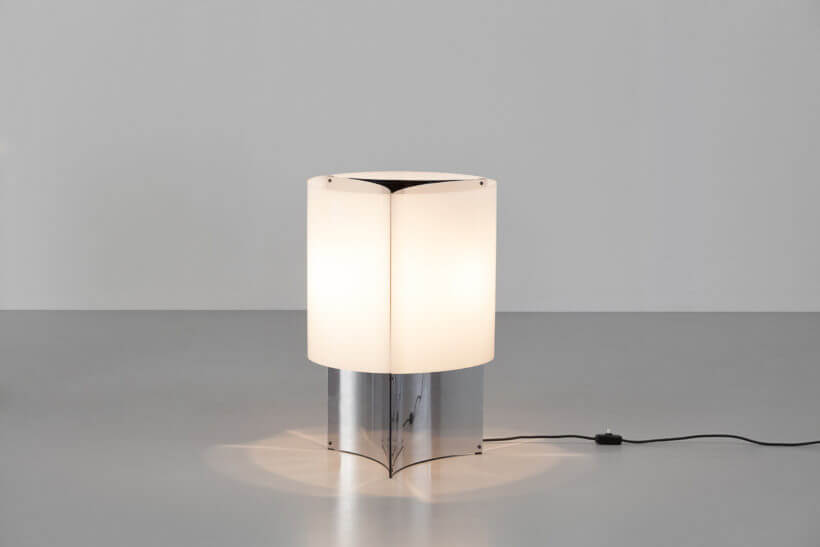 Model No. 526/g, the bigger version of the two, in all its glory (source: Galerie A1043).
Model No. 526/g, the bigger version of the two, in all its glory (source: Galerie A1043).
-
Model No. 526 is a table lamp with a base that consists of three concave chromed sheets. This base is covered by white Perspex shades. The lamp was released in two different sizes. The smallest was 45 cm high and the other was 60 cm high and could therefore also be used as a floor lamp.
Giuliana Gramigna mentions this beautiful lamp in the standard work on Italian design Repertoire del Design Italiano 1950-2000 on page 121 (1965).
-
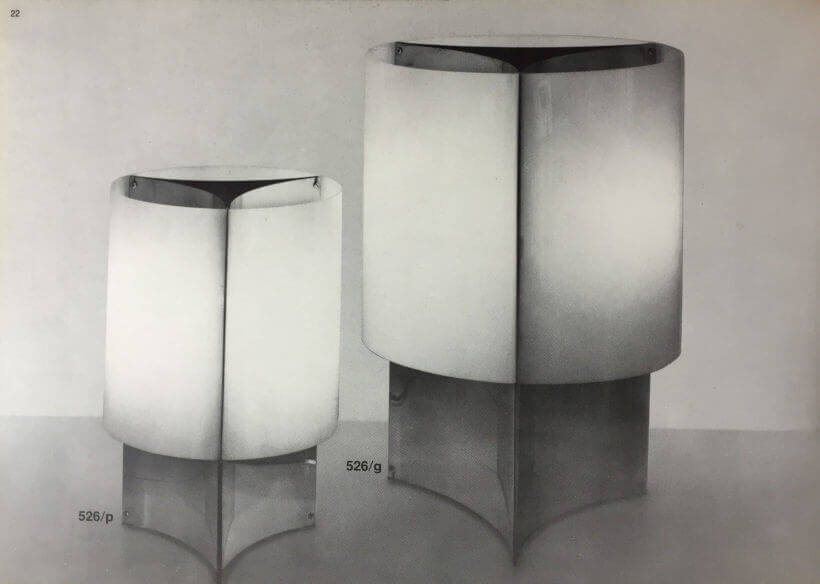 Model No. 526/p and Model No. 526/g
(source: Arteluce − Catalogue AL Milano, from the Palainco archive).
Model No. 526/p and Model No. 526/g
(source: Arteluce − Catalogue AL Milano, from the Palainco archive).
-
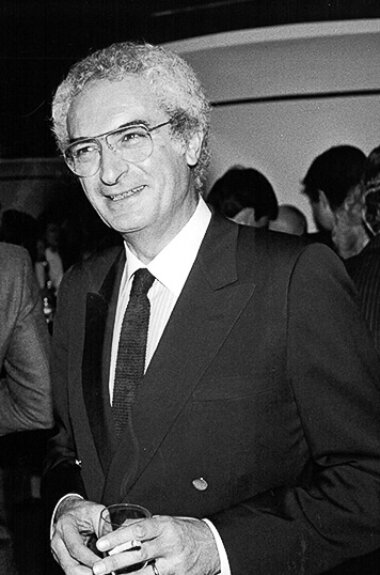 Massimo Vignelli in 1981 (source: Knoll)
Massimo Vignelli in 1981 (source: Knoll)
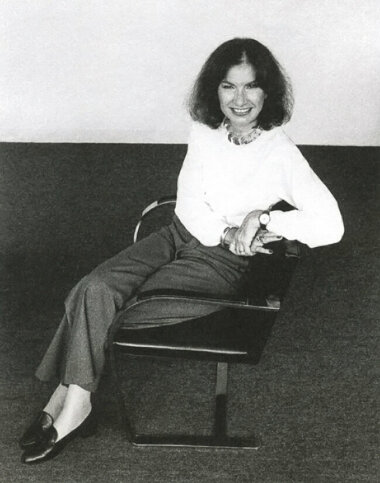 Lella Vignelli in 1980 in NYC (source: Core 77)
Lella Vignelli in 1980 in NYC (source: Core 77)
-
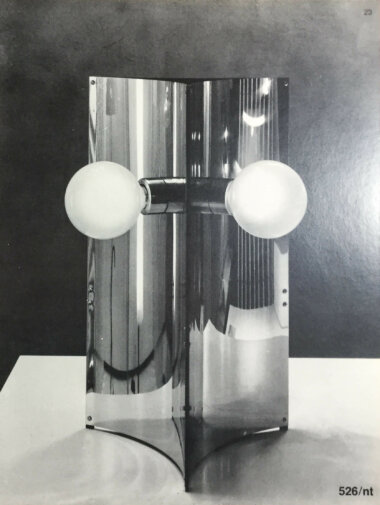 Model No. 526/nt, a further developed version of Model No. 526/g by Gino Sarfatti
(source: Arteluce − Catalogue AL Milano, from the Palainco archive).
Model No. 526/nt, a further developed version of Model No. 526/g by Gino Sarfatti
(source: Arteluce − Catalogue AL Milano, from the Palainco archive).
-
In 1971 Gino Sarfatti decided to introduce a new variant of Model No. 526/g, which at the time probably better fitted the style of the prevailing era. He left out the Perspex shades and he replaced the regular light bulbs by large bulbs.
The new model would already give more light because of the removal of the shades and because the chrome reflects the light, but Sarfatti even recommended using stronger bulbs. The recommended wattage of the light bulb of Model No. 526/g was 3 x 60 W, while for the new model 3 x 100 W is recommended. Because the light bulbs should be opaline the brightness would be slightly reduced.
The differences between the old and new variant are clearly visible when photographed from above.
-
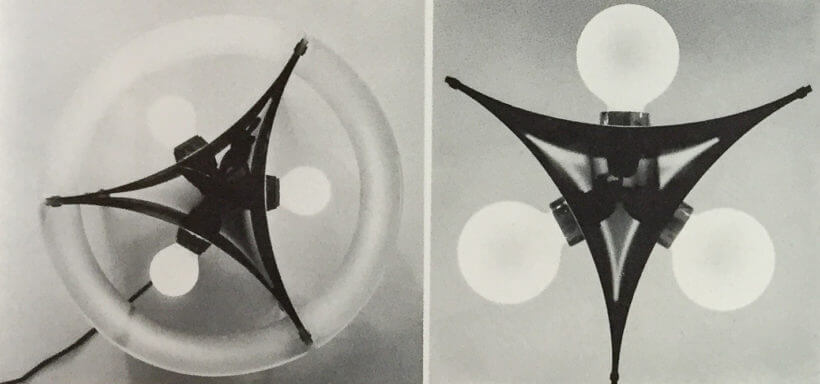 The difference between Model No. 526 and Model No. 526/nt seen from above (source: Arteluce − Catalogue AL Milano, from the Palainco archive).
The difference between Model No. 526 and Model No. 526/nt seen from above (source: Arteluce − Catalogue AL Milano, from the Palainco archive).
-
In 1964 Massimo Vignelli designed two wall lamps and two pendants in which he combined anodised aluminium frames with white fabric fringe lampshades.
-
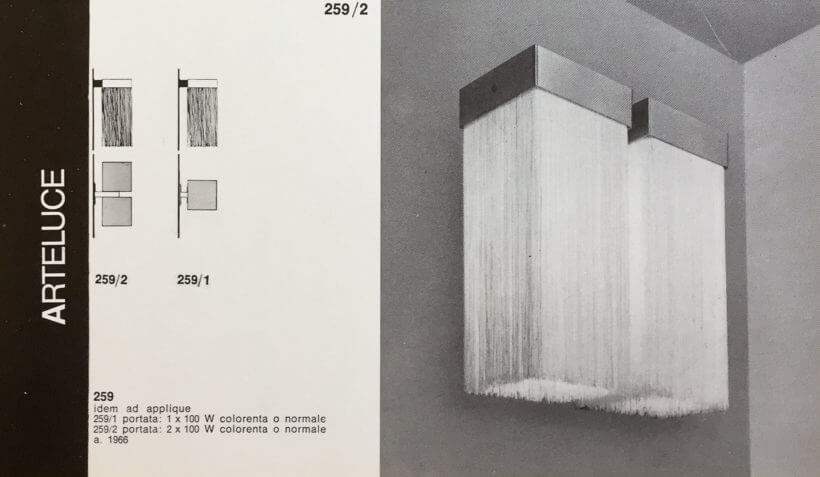 Wall Lamps No. 259/1 and No. 259/2 by Massimo Vignelli in 1964
(source: Arteluce − Catalogue No. 01, from the Palainco archive).
Wall Lamps No. 259/1 and No. 259/2 by Massimo Vignelli in 1964
(source: Arteluce − Catalogue No. 01, from the Palainco archive).
-
Michael Bierut, who worked for Massimo Vignelli for ten years, wrote in 2001 in Domus No. 835: “Unlike many designers, he didn’t mind being imitated. On the contrary, he prided himself on creating solutions that could be replicated, systems that were so foolproof that anyone could do them.”
Apparently this also worked the other way around, as the idea of working with fringes was used earlier by Gino Sarfatti, the founder of Arteluce, and by architect Gianfranco Frattini.
-
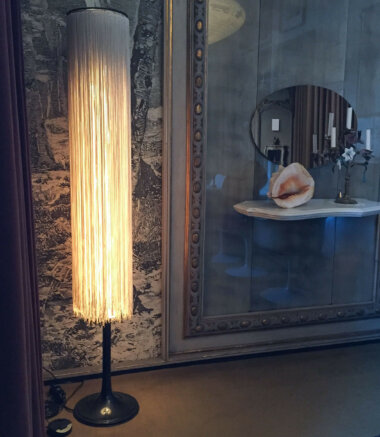 Floor Lamp No. 1091 by Gino Sarfatti in 1963 in Casa Mollino, Turin (source: Palainco).
Floor Lamp No. 1091 by Gino Sarfatti in 1963 in Casa Mollino, Turin (source: Palainco).
 Table Lamp No. 597 designed by Gianfranco Frattini in 1963 in Casa Mollino, Turin (source: Palainco).
Table Lamp No. 597 designed by Gianfranco Frattini in 1963 in Casa Mollino, Turin (source: Palainco).
-
But the designs by Massimo Vignelli are far too special to suggest that he imitated his colleagues. And when Michael Bierut described Vignelli’s attitude in Domus No. 835: “Always optimistic, never cynical, Massimo had a hunger for new design challenges and approached every job as if he had never done such a thing before.”−he unmistakably implied that replicating was certainly not Vignelli’s style.
-
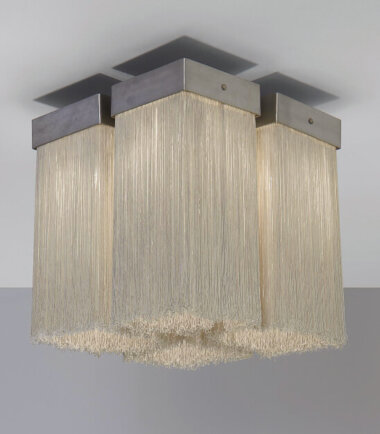 Pendant 2049/4 by Massimo Vignelli in 1964 (source: Phillips).
Pendant 2049/4 by Massimo Vignelli in 1964 (source: Phillips).
In the case of Model No. 259 and Model No. 2049 Vignelli chose a material that had been selected before, but used it in a completely different manner. It is much easier to sum up differences between the models of Sarfatti and Frattini and the lamps by Vignelli than similarities.
To mention a few: Vignelli designed a wall lamp and a pendant where Sarfatti designed floor lamps and Frattini a table lamp. The shape of the lamps of Vignelli is square while the earlier designs were round. The lamps of Vignelli consist of different compartments, the others do not.
-
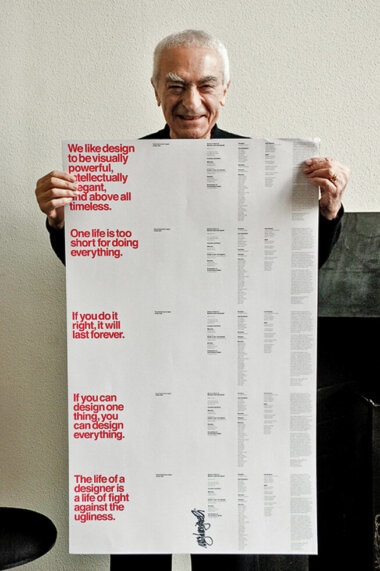 Massimo Vignelli with the program, designed by Michael Bierut of Pentagram, for the Architectural League President’s Medal event, which he and Lella were awarded in 2011 (source: Pentagram).
Massimo Vignelli with the program, designed by Michael Bierut of Pentagram, for the Architectural League President’s Medal event, which he and Lella were awarded in 2011 (source: Pentagram).
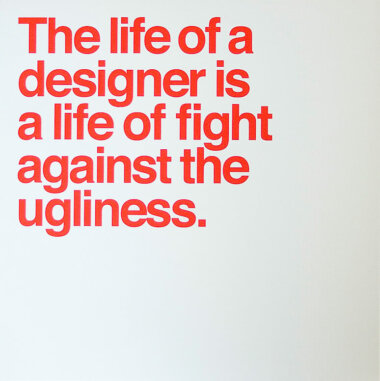
-
Massimo Vignelli has received rewards too numerous to list. Some of his many awards include: Gran Premio Triennial di Milano, 1964; Compasso d’Oro in 1964 and again in 1998; the 1973 Industrial Arts Medal of the American Institute of Architects (AIA); the 1982 Art Directors Club Hall of Fame; and the first Presidential Design Award, presented in 1985. In 2003, Lella and Massimo Vignelli received the National Design Lifetime Achievement Award and in 2011 they were awarded with the Architectural League President’s Medal.
We think that he also deserved a reward for his “fight against the ugliness”!
-
If you would like to be the first to read articles on designers and special designs, please subscribe to our newsletter.
-
- Literature: Michael Bierut & Domus No. 835.
Unless otherwise stated, all material is sourced and/or generated internally. All rights reserved.
- Text: Palainco, Koos Logger & Ingrid Stadler.
- Image sources: Palainco, Arteluce - Catalogue AL Milano, Arteluce - Catalogue No. 01, A1043, Phillips, Knoll, Core 77, Pentagram & the Palainco Archive.
The article and its contents may not be copied or reproduced in any part or form without the prior written permission of the copyright holders.
Published on: 2 November 2018